Menorca
Menorca (Catalan: [məˈnɔɾkə], Spanish: [meˈnoɾka]) or Minorca (English: /mɪˈnɔːrkə/ min-OR-kə; from Latin: Insula Minor, lit. 'smaller island', later Minorica) is one of the Balearic Islands located in the Mediterranean Sea belonging to Spain. Its name derives from its size, contrasting it with nearby Mallorca. Its largest city and capital is Mahón on the island's eastern side, although Menorca is not a province and forms a political union with the other islands in the archipelago.
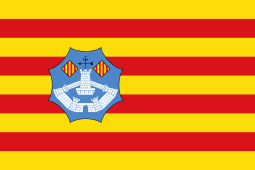 | |
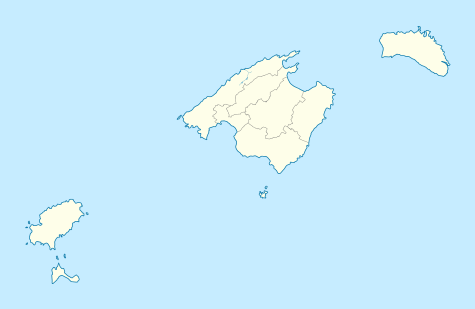 Menorca Minorca  Menorca Minorca | |
| Geography | |
|---|---|
| Location | Mediterranean Sea |
| Coordinates | 39°58′N 4°05′E |
| Archipelago | Balearic Islands |
| Area | 695.7 km2 (268.6 sq mi) |
| Highest elevation | 358 m (1,175 ft) |
| Highest point | Monte Toro |
| Administration | |
Spain | |
| Autonomous Community | Balearic Islands |
| Province | Balearic Islands |
| Capital and largest city | Mahón (pop. 29,040) |
| Demographics | |
| Demonym | Menorcan |
| Population | 93,397 (1 January 2019) |
| Pop. density | 134.25/km2 (347.71/sq mi) |
Menorca has a population of approximately 93,397 (at 1 January 2019).[1] It is located 39°47' to 40°00'N, 3°52' to 4°24'E. Its highest point, called El Toro or Monte Toro, is 358 metres (1,175 feet) above sea level.
History
The island is known for its collection of megalithic stone monuments: navetes, taules and talaiots, which indicate very early prehistoric human activity. Some of the earliest culture on Menorca was influenced by other Mediterranean cultures, including the Greek Minoans of ancient Crete (see also Gymnesian Islands). For example, the use of inverted plastered timber columns at Knossos is thought to have influenced early peoples of Menorca in imitating this practice.[2]
The end of the Punic wars saw an increase in piracy in the western Mediterranean. The Roman occupation of Hispania had meant a growth of maritime trade between the Iberian and Italian peninsulas. Pirates took advantage of the strategic location of the Balearic Islands to raid Roman commerce, using both Menorca and Majorca as bases. In reaction to this, the Romans invaded Menorca. By 123 BC both islands were fully under Roman control, later being incorporated into the province of Hispania Citerior.
In 13 BC Roman emperor Augustus reorganised the provincial system and the Balearic Islands became part of the Tarraconensis imperial province. The ancient town of Mago was transformed from a Carthaginian town to a Roman town.[3]
Jews of Menorca
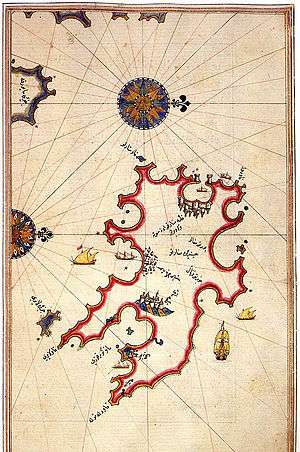
The island had a Jewish population.[4] The Letter on the Conversion of the Jews by a 5th-century bishop named Severus tells of the forced conversion of the island's 540 Jewish men and women in AD 418.[5] Several Jews, including Theodore, a rich representative Jew who stood high in the estimation of his coreligionists and of Christians alike, underwent baptism. The act of conversion brought about, within a previously peaceful coexisting community, the expulsion of the ruling Jewish elite into the bleak hinterlands, the burning of synagogues, and the gradual reinstatement of certain Jewish families after the forced acceptance of Christianity, allowing the survival of those Jewish families who had not already perished.[4] Many Jews remained within the Jewish faith while outwardly professing Christian faith. Some of these Jews form part of the Xueta community.
When Menorca became a British possession in 1713, they actively encouraged the immigration of foreign non-Catholics, which included Jews who were not accepted by the predominantly Christian inhabitants. When the Jewish community in Mahon requested the use of a room as a synagogue, their request was refused and they were denounced by the clergy. In 1781, when Louis des Balbes de Berton de Crillon, duc de Mahon invaded Menorca, he ordered all Jews to leave in four days. At that time, the Jewish community consisted of about 500 people and they were transported from Menorca in four Spanish ships to the port of Marseille.[6]
Middle Ages
The Vandals easily conquered the island in the 5th century. The Byzantine Empire recovered it in 534. Following the Moorish conquest of peninsular Spain, Menorca was annexed to the Caliphate of Córdoba in 903, with many Moors emigrating to the island.
Manûrqa (Arabic: منورقة) was the Arabicized name given to the island by the Muslims from its annexation to the Caliphate of Cordoba by 'Isâm al-Khawlânî in 903 until the rule of the last Muslim ra'îs, Abû 'Umar ibn Sa'îd in 1287. The only urban centre of the island was Madînat al Jazîra or al Manûrqa (modern Ciutadella). Most of the population lived in small farm communities organized under a tribal structure.
In 1231, after Christian forces took Majorca, Menorca chose to become an independent Islamic state, albeit one tributary to King James I of Aragon. The island was ruled first by Abû 'Uthmân Sa'îd Hakam al Qurashi (1234–1282), and following his death by his son, Abû 'Umar ibn Sa'îd (1282–1287).
A Catalan-Aragonese invasion, led by Alfonso III, came on 17 January 1287; its anniversary is now celebrated as Menorca's national day. Once the island was captured, most of its Muslim inhabitants were enslaved and sold in the slave markets of Ibiza, Valencia and Barcelona, while others became Christians.
After the Christian conquest of 1287, the island was part of the Crown of Aragon. For some time it was ceded to the Kingdom of Majorca, a vassal state of the Crown, but it was retaken by the king of Aragon in 1343. Eventually the Crown of Aragon merged with the Crown of Castile, and so Menorca became part of Spain.
During the 16th century, Turkish naval attacks destroyed Mahon, and the then capital, Ciutadella. In Mahon, Barbary pirates from North Africa took considerable booty and as many as 6,000 slaves.[7] Various Spanish kings, including Philip III and Philip IV, styled themselves "King of Minorca" as a subsidiary title.
18th century
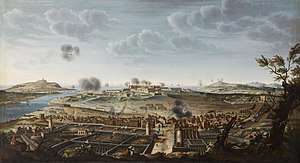
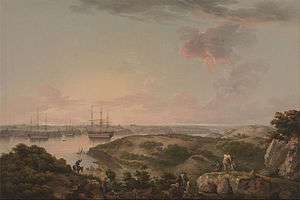
Captured by Britain's Royal Navy in 1708 during the War of the Spanish Succession, Minorca temporarily became a British possession. Great Britain took possession in 1713, under the terms of Article XI of the Treaty of Utrecht. Under the governorship of General Richard Kane, this period saw the island's capital moved to Port Mahon and a naval base established in that town's harbour.
In 1756, during the Seven Years' War, France captured the island after the Siege of Fort St Philip and a failed British relief attempt. The 1763 Treaty of Paris enabled the British to return to the island after Britain's victory in the Seven Years' War. In 1781, during the American War of Independence, the British were defeated for a second time, in this instance by a combination of French and Spanish forces, and on 5 January 1782 the Spanish regained control of the island, after a long siege of St. Philip's Castle in Port Mahon. On the feast of the Epiphany, as an expression of joy, King Charles III of Spain ordered the viceroys, captains general, governors, and military commanders to bring together the garrisons and to extend his greetings to army commanders on the so-called Pascua Militar. The British ceded the island back to Spain the next year in the Treaty of Versailles. Menorca was invaded by the British once again in 1798, during the French Revolutionary Wars, but it was finally repossessed by Spain by the terms of the Treaty of Amiens in 1802. The British influence can still be seen in local architecture, with elements such as sash windows.
As with the rest of the Balearic Islands, Menorca was not occupied by the French during the Peninsular War, as it was successfully protected by the Royal Navy, this time allied to Spain.
Post-1900
During the Spanish Civil War, Menorca stayed loyal to the Republican Spanish Government, while the rest of the Balearic Islands supported the Nationalists. It did not see ground combat, however the island was a target of aerial bombing by the pro-Nationalist Italians of Corpo Truppe Volontarie Air Force. Many Minorcans were also killed when taking part in a failed invasion of Majorca. During the Pedro Marqués Barber era (July–December 1936) some Majorcans and a priest were executed on the island. After the Nationalist victory in the Battle of Minorca in February 1939, the British Navy assisted in a peaceful transfer of power in Minorca and the evacuation of some political refugees aboard HMS Devonshire.
In October 1993, Minorca was designated by UNESCO as a biosphere reserve. In July 2005, the island's application to become the 25th member of the International Island Games Association was approved.
Climate
As the major part of Balearic Islands, Menorca has a mediterranean climate (Köppen: Csa), with mild winters and hot summers.
| Climate data for Mahón – Minorca Airport 91m (1981–2010), Extremes (1965–2017) | |||||||||||||
|---|---|---|---|---|---|---|---|---|---|---|---|---|---|
| Month | Jan | Feb | Mar | Apr | May | Jun | Jul | Aug | Sep | Oct | Nov | Dec | Year |
| Record high °C (°F) | 21.2 (70.2) |
21.6 (70.9) |
27.2 (81.0) |
27.7 (81.9) |
30.7 (87.3) |
34.4 (93.9) |
39.6 (103.3) |
37.8 (100.0) |
34.5 (94.1) |
31.3 (88.3) |
25.4 (77.7) |
21.6 (70.9) |
39.6 (103.3) |
| Mean maximum °C (°F) | 17.6 (63.7) |
18.0 (64.4) |
20.6 (69.1) |
22.5 (72.5) |
26.5 (79.7) |
31.2 (88.2) |
33.0 (91.4) |
33.2 (91.8) |
29.7 (85.5) |
26.4 (79.5) |
22.4 (72.3) |
19.0 (66.2) |
34.0 (93.2) |
| Average high °C (°F) | 14.1 (57.4) |
14.2 (57.6) |
15.9 (60.6) |
18.0 (64.4) |
21.6 (70.9) |
25.8 (78.4) |
28.9 (84.0) |
29.2 (84.6) |
26.2 (79.2) |
22.7 (72.9) |
18.1 (64.6) |
15.2 (59.4) |
20.8 (69.4) |
| Daily mean °C (°F) | 10.8 (51.4) |
10.8 (51.4) |
12.3 (54.1) |
14.3 (57.7) |
17.8 (64.0) |
21.8 (71.2) |
24.9 (76.8) |
25.4 (77.7) |
22.6 (72.7) |
19.4 (66.9) |
14.9 (58.8) |
12.1 (53.8) |
17.2 (63.0) |
| Average low °C (°F) | 7.5 (45.5) |
7.4 (45.3) |
8.6 (47.5) |
10.6 (51.1) |
13.9 (57.0) |
17.8 (64.0) |
20.8 (69.4) |
21.5 (70.7) |
18.9 (66.0) |
16.1 (61.0) |
11.6 (52.9) |
9.0 (48.2) |
13.6 (56.5) |
| Mean minimum °C (°F) | 3.6 (38.5) |
3.2 (37.8) |
4.6 (40.3) |
6.6 (43.9) |
10.4 (50.7) |
13.7 (56.7) |
17.4 (63.3) |
17.9 (64.2) |
15.0 (59.0) |
11.1 (52.0) |
6.8 (44.2) |
4.5 (40.1) |
2.2 (36.0) |
| Record low °C (°F) | −2.4 (27.7) |
−1.1 (30.0) |
−0.1 (31.8) |
1.6 (34.9) |
6.4 (43.5) |
10.2 (50.4) |
13.6 (56.5) |
13.6 (56.5) |
9.4 (48.9) |
5.2 (41.4) |
2.0 (35.6) |
−1.0 (30.2) |
−2.4 (27.7) |
| Average precipitation mm (inches) | 52 (2.0) |
54 (2.1) |
38 (1.5) |
45 (1.8) |
37 (1.5) |
14 (0.6) |
3 (0.1) |
20 (0.8) |
61 (2.4) |
78 (3.1) |
88 (3.5) |
61 (2.4) |
546 (21.5) |
| Average precipitation days (≥ 1 mm) | 7 | 7 | 6 | 6 | 4 | 2 | 1 | 2 | 5 | 7 | 8 | 9 | 64 |
| Mean monthly sunshine hours | 144 | 146 | 202 | 222 | 270 | 311 | 347 | 312 | 225 | 183 | 142 | 130 | 2,632 |
| Source 1: Agencia Estatal de Meteorología[8] | |||||||||||||
| Source 2: Agencia Estatal de Meteorología[9] | |||||||||||||
| Climate data for Menorca | |||||||||||||
|---|---|---|---|---|---|---|---|---|---|---|---|---|---|
| Month | Jan | Feb | Mar | Apr | May | Jun | Jul | Aug | Sep | Oct | Nov | Dec | Year |
| Average sea temperature °C (°F) | 14.6 (58) |
13.8 (57) |
14.1 (57) |
15.7 (60) |
18.7 (66) |
22.2 (72) |
24.4 (76) |
25.8 (78) |
25.1 (77) |
22.9 (73) |
20.4 (69) |
17.1 (63) |
19.4 (67) |
| Average Ultraviolet index | 2 | 3 | 5 | 6 | 8 | 9 | 9 | 8 | 6 | 4 | 2 | 2 | 5.3 |
| Source #1: seatemperature.org [10] | |||||||||||||
| Source #2: Weather Atlas [11] | |||||||||||||
Culture
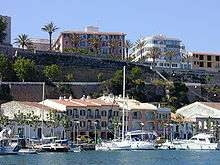
The location of Minorca in the middle of the western Mediterranean was a staging point for the different cultures since prehistoric times. This Balearic Island has a mix of colonial and local architecture.
The festes take place throughout the summer in different towns around the island, and have their origins in the early 14th century.[12] The international opera week and international organ festival in Mahon, and the summer music festival and Capella Davidica concerts in Ciutadella are the main events of the island.
Minorca's cuisine is dominated by the Mediterranean diet which is known to be very healthy. While many of the locals have adopted modern attitudes they still uphold certain old traditions.[13]
Traditional celebrations
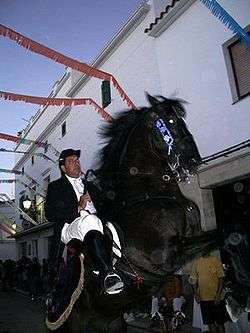
Minorca is especially well known for its traditional summer fiestas, which intrigue many visitors. The Festes de Sant Joan are held annually in Ciutadella de Menorca, during 23–25 June. The festes last for three days. On the first day, a man bears a well-groomed sheep upon his shoulders and parades around the local streets. In the late evening, main streets are closed and bonfires held upon them.
On the second day, locally bred black horses are dressed with ribbons and rosettes. The riders, or "caixers", ride the horses through the streets and, along with a tumultuous crowd of people, encourage them to rear up on their hind legs. The brave can be found running underneath them in an attempt to touch the horses hearts for good luck.
The third day sees intense competition between the riders in a harmless form of jousting that involves spearing a suspended ring with a lance at considerable speed. The festes are brought to a close with a firework display.
Sports
As a small island, opportunities to see top level sport competitions in Menorca are limited. Football in Menorca is played at the fifth level of the Spanish football pyramid. There are currently 11 clubs contesting the Regional Preferente de Menorca, the champion of which progresses to the Tercera División Grupo XI playoffs. The winner of this playoff is promoted to Tercera División; the last Menorquí club to do so was CF Sporting Mahonés in 2009.
CV Ciutadella are a professional women's volleyball club who play in the Superliga Femenina, the top league of Spanish volleyball, having won the league championship in 2011 and 2012. They play at Pavelló Municipal d'Esports in Ciutadella.
A semi-pro basketball club, CB Menorca, play in the LEB Plata, the third level of Spanish basketball. Their home court is Pavelló Menorca in the Bintaufa neighborhood just outside of Maó.
In recent years, some sport events that gather hundreds of participants are successfully held on a yearly basis, such as the triathlon race Extreme Man Menorca or the single-staged ultramarathon race Trail Menorca Camí de Cavalls. In 2014 it was announced that the island would host the 18th editions of the Island Games in 2019, however Menorca later pulled out of hosting the event, citing a change of government as the main reason.[14]
Language
The two official languages are Catalan and Spanish.[15] Natives to the island speak the variety of Catalan called Menorquí, and Spanish as well; many residents originating from the mainland are monolingual in Spanish.
A 2014 survey carried out by the Government of the Balearic Islands found that 53.5% of participants identified themselves as Catalan speakers, 36.7% as Spanish speakers, and 7.7% as bilingual speakers.[16]
The Catalan spoken in Menorca is a variety known as Menorquí. Between Menorquí and standard Catalan, as with most Balearic dialects, the most distinctive difference is the word used for the article "the", where Menorquí uses "es" for masculine and "sa" for feminine. Menorquí thus shares the source of its article with many Sardinian varieties (masc. sing. su, fem sing. sa), rather than the standard Catalan "el" and "la", similar to other Romance languages (e.g. Spanish el, la, Italian il, la), corresponding to a form which was historically used along the Costa Brava of Catalonia, from where it is supposed that the islands were repopulated after being conquered from the Moors.
Menorquí also has a few English loan words dating back to the British rule such as "grevi", "xumaquer", "boinder" and "xoc" taken from "gravy", "shoemaker", "bow window" and "chalk", respectively.[17]
Food and drink
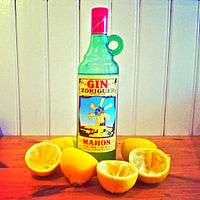
Wine production has been known on the island since ancient times, but it went into a heavy decline over the last century. Now, several new, small wineries have started up, producing wines locally.[18]
Lingering British influence is seen in the Menorcans' taste for gin, which during local festes honoring towns' patron saints is mixed with lemonade (or bitter lemon) to make a golden liquid known as Pomada. Gin from Menorca is not derived from grain alcohol but from wine alcohol (eau de vie de vin), making it more akin to brandy. It has the distinction to have geographical identity protection. Probably the best known gin is Gin Xoriguer which is named after the typical Menorcan windmill which was used to make the first gin. One of the reasons it is also known as Gin de Minorca or Gin de Mahón.
Also famous is Mahón cheese, a cheese typical of the island.
One origin story of mayonnaise is that it was brought back to France from Mahon, Menorca, after Louis-François-Armand du Plessis de Richelieu's victory over the British at the city's port in 1756.[19]
Sweets known as flaons are one of the typical gastronomic products of Menorca.
Wildlife
Flowers
Menorca is rich in wild flowers with over 900 species of flowering plants recorded. Many are those typical of the Mediterranean but some are endemic. There are 24 or 25 species of orchid found and of these most flower early in the year in late March, April and May.
Insects

30 species of butterflies have been recorded on Menorca and most are on the wing from March to late September. The species that occur include the Cleopatra, Lang's short tailed blue and the two-tailed pasha.
Despite not having many large wetlands dragonflies abound on Menorca. Seventeen species have been recorded including the emperor dragonfly.
Reptiles and amphibians
There are three species of amphibia: green toad (Bufo viridis), marsh frog and stripeless tree frog (Hyla meridionalis). The common lizard seen all over the island is the Italian wall lizard (Podarcis siculus) although the Moroccan rock lizard (Scelaris perspicillata) also occurs. The Balearic endemic Lilford's wall lizard (Podarcis lilfordi) can be found on many of the offshore islands. Two species of gecko can be found on Menorca, the Moorish (Tarentola mauritanica) and the Turkish (Hemidactylus turcicus) also called the Mediterranean house gecko. Four species of snake occur: the viperine snake (Natrix maura), grass snake, false smooth snake (Macroprotodon cucullatus) and the ladder snake (Rhinechis scalaris).
Hermann's tortoise (Testudo hermanni) is quite common and can be found all over the island. Two terrapin species are also found, the native European pond terrapin (Emys orbicularis) and the introduced American red-eared slider (Trachemys scripta).
Birds
The birdlife of Menorca is very well known. Menorca is a well watched island which is on the migration route of many species and good number of passage migrants can be seen in spring.[20] Residents include Audouin's gull, blue rock thrush and Thekla lark. Booted eagle and red kite are easy to see as is Egyptian vulture in the right habitat. In summer there are bee-eaters and Menorca has major colonies of Cory's shearwater and Balearic shearwater.
Mammals
Menorca has no large native mammals. There are some small mammals including rabbits, bats, rats, mice, pine martens and a subspecies of North African hedgehog.
Municipalities
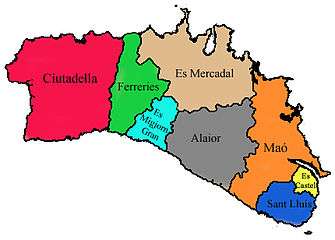
The major towns are Port Mahon and Ciutadella de Menorca. The island is administratively divided into eight municipalities (from west to east):
- Ciutadella de Menorca (or just Ciutadella locally) – the ancient capital of Menorca until 1722.
- Ferreries
- Es Mercadal
- Fornells, which belongs to the municipality of Es Mercadal. Famous for its lobster stew.
- Es Migjorn Gran (or Es Mitjorn Gran) – hometown of Joan Riudavets.
- Alaior
- Cala En Porter – a tourist and residential area
- Port Mahon (officially Maó in Catalan, Mahón in Spanish) – became the capital in 1722 during British rule due to its strategic natural harbour.
- Llucmassanes – a small hamlet which belongs to the municipality of Maó.
- Sant Climent, which belongs to the municipality of Maó.
- Es Castell – Founded by the British and originally named as Georgetown.
- Sant Lluís – Founded by the French and originally named Saint-Louis.
The areas and populations of the municipalities (according to the Instituto Nacional de Estadística, Spain) are:
| Municipality | Area (km2) |
Census Population 1 November 2001 |
Census Population 1 November 2011 |
Estimated Population 1 January 2019 |
|---|---|---|---|---|
| Ciutadella de Menorca | 186.3 | 23,103 | 29,510 | 29,840 |
| Ferreries | 66.1 | 4,048 | 4,667 | 4,777 |
| Es Mercadal | 138.3 | 3,089 | 5,292 | 5,038 |
| Es Migjorn Gran | 31.4 | 1,167 | 1,520 | 1,405 |
| Alaior | 109.9 | 7,108 | 9,450 | 9,065 |
| Port Mahon (Maó) | 117.2 | 23,315 | 28,789 | 29,040 |
| Es Castell | 11.7 | 6,424 | 7,895 | 7,434 |
| Sant Lluís | 34.8 | 3,270 | 7,275 | 6,798 |
| Totals | 695.7 | 71,524 | 94,398 | 93,397 |
Gallery
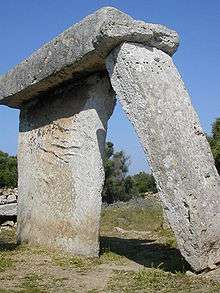 Taula from the site of Talatí de Dalt about 4 km (2 mi) west of Maó.
Taula from the site of Talatí de Dalt about 4 km (2 mi) west of Maó.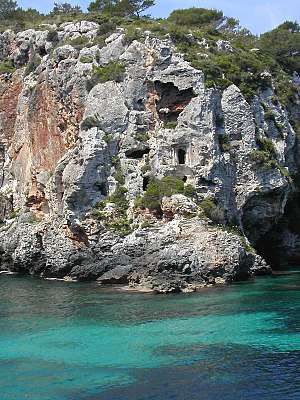 Cales Coves of Menorca. Note the hand-hewn entrances to the caves.
Cales Coves of Menorca. Note the hand-hewn entrances to the caves.- Menorcan countryside
- Cala Trebalúger
 Martello tower, Alcaufar with Illa de l'aire lighthouse in the distance.
Martello tower, Alcaufar with Illa de l'aire lighthouse in the distance..jpg) Cala Galdana
Cala Galdana Arenal d'en Castell
Arenal d'en Castell
See also
References
- Instituto Nacional de Estadística, Madrid, 2019.
- C. Michael Hogan (2007) Knossos fieldnotes, The Modern Antiquarian
- Henry Christmas, The Shores and Islands of the Mediterranean, Published 1851, R. Bentley
- Elukin, Jonathan M. Living Together, Living Apart : Rethinking Jewish-Christian Relations in the Middle Ages. Vol. Jews, Christians, and Muslims from the ancient to the modern world. Princeton, N.J.: Princeton University Press, 2007.
- Bradbury, Scott, ed. trans. (1996). Severus of Minorca: Letter on the Conversion of the Jews (Oxford Early Christian Texts). Oxford University Press. p. 154. ISBN 978-0-19-826764-5.
- Gregory, Desmond (1990). Minorca, the Illusory Prize: A History of the British Occupations of Minorca between 1708 and 1802. Cranbury, NJ, USA: Associated University Presses, Inc. p. 132. ISBN 0-8386-3389-7.
- M. Th. Houtsma (1993). E. J. Brill's First Encyclopaedia of Islam, 1913–1936. BRILL. p. 872. ISBN 90-04-09790-2.
- "Valores Climatológicos Normales. Minorca / Aeropuerto". November 2015.
- "Valores Climatológicos Extremos. Minorca / Aeropuerto". December 2017.
- "Menorca Sea Temperature". seatemperature.org. Retrieved 14 December 2017.
- "Ciutadella de Menorca, Spain – Monthly weather forecast and Climate data". Weather Atlas. Retrieved 14 December 2017.
- Website Oficial Minorca
- "Minorca Geography – Information, climate and weather in Minorca". www.minorca.com. Archived from the original on 13 March 2009. Retrieved 31 March 2009.
- "Island Games: Menorca pull out of hosting 2019 event". 6 July 2015 – via www.bbc.co.uk.
- Article 4, Statute of Autonomy of the Balearic Islands, 2007: "The Catalan language, typical of the Balearic Islands, will have official consideration, together with Spanish."
- Diario de Ibiza: Las Pitiusas son las islas de Balears en las que menos se conoce y se usa el catalán (In Spanish)
- Menorquin English words.
- Miquel Hudin (2013), Vinologue Minorca, Leavenworth Press, p. 75, ISBN 978-0-983-77187-6
- Trager, James (1995). The Food Chronology. New York: Henry Hold and Company. p. 163.
- "Migrant Birds of Menorca".
Further reading
- Burns, Robert I., (1990) "Muslims in the Thirteenth Century Realms of Aragon: Interaction and Reaction", p. 67, In: Powell, J.M. (ed.) Muslims under Latin Rule, 1100–1300, p. 57–102, Princeton University Press. ISBN 0-691-05586-6.
- Fernandez-Arnesto, F. Before Columbus: Exploration and Colonisation from the Mediterranean to the Atlantic 1229–1492; Mac Millan, 1987. p. 36.* Hearl, G., (1996). A Birdwatchers guide to Minorca, Ibiza and Formentera. Arlequin Press. pp56. ISBN 1-900159-20-1
- Carlo Ginzburg, "The Conversion of the Jews of Minorca (A.D. 417–418)," in Idem, Threads and Traces: True False Fictive (Berkeley, University of California Press, 2011)
- Moll Mercadal, B. Abû 'Uthmân Sa'îd ibn Hakam, Ra'îs de Manûrqa (631/1234-680/1289) Publicacions des Born nº5. 1999
- Pons, G., (2000). Les papallones diurnes de les balears., pp87. Edicions Documenta Balear, Palma de Mallorca.
- Taylor, David Wilson (1975). Minorca. ISBN 0 7153 6787 0 (Great Britain) ISBN 0 8117 1032 7 (United States) First full account of Minorca in English since John Armstrong's memoirs of 1740.
- Laurie, John Bruce (1994) The Life of Richard Kane, Britain's First Lieutenant-Governor of Menorca ISBN 84-606-3275-X
External links
| Wikimedia Commons has media related to Menorca. |